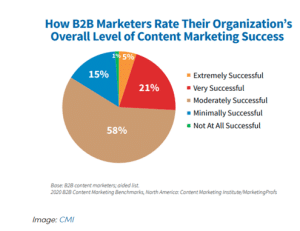
Employee Advocacy: 3 Crucial Tips to Improving Content And Engagement
One of the biggest challenges when it comes to Content Marketing strategy is the content itself. As Michael Brenner explains, most of the content produced by marketer’s “sucks.” It just isn’t engaging or relevant. And Content Marketers know it. 58% of B2B marketers only rate their content as “moderately successful.”

Of course, Content Marketers don’t create bad content on purpose. Most of the time, the low level of quality is simply due to a lack of budget. The formats tailored for modern communication, especially when it comes to social networks, are widely underused.
However, there are other factors as well, as to why the content doesn’t reach its full potential. For example:
Lack of authenticity. The content is produced with a fake-sounding corporate tone that simply doesn’t speak to real people. They just tune it out.
Content doesn’t add value. It may be too generic, especially if the true experts in the field who actually know the material are not part of the content creation process.
Lack of context. For example, global content might be published only in English and pushed to other countries, where local subs don’t want to use it.
Employee Advocacy is a solution to the “human” problem of Content Marketing.
One of the most effective solutions to getting around these problems of authenticity, value, and context, is to activate your employees – put the distribution and even creation of content into the hands of the employees themselves, as a more effective way to promote the company and its brand.
This is the core of Employee Advocacy. Having actual human beings sharing and creating content in their own words, and spreading it via their own social networks, makes it more authentic, more “real.”
And it works. Content shared by employees receives 8x more engagement than content shared by brand channels. Leads developed through employee social marketing convert 7x more frequently than those coming directly from the company.
Beyond authenticity, Employee Advocacy also raises an army of content creators.
Getting employees involved in the creation of content means that not only are you going to have more authentic producers of content, they’re also going to be producing content on a local level, using what is relevant to their audience.
Of course, some Marketers will be concerned that the employees are not able to produce content at the quality level they desire. This comes in part from their own frustrations creating good, shareable content.
However, effective content isn’t always about sophistication of production. Sharing pictures, moments of company life, their own opinion of an article or thought piece as it relates to their company—all of this can be effective.
Launching an Employee Advocacy program isn’t rocket science. But it does take some work.
Many companies struggle with the motivation aspect. They aren’t sure how to suddenly get their employees sharing, creating, and commenting on content. It may appear daunting at first, but it really isn’t that complicated if you follow these three easy steps:
#1. Provide minimum guidelines to employees. Explain what is expected of them, and show them how to do it in a simple way they can understand, with concrete examples. Once employees know the expectations and guidelines, they will rise to meet them.
#2. Give them a library of content. Each month, provide access to photos, images, and infographics they can use, to make it easier for them to share and comment. Give them the nudge and raw materials they need to start sharing content, while also giving them the freedom to give it a personal touch.
#3. Motivate their engagement throughout. Don’t just engage employees at the beginning of the program, but rather as a constant part of the process. A gamification framework with rewards and badges can be effective, but also showcase their posts to other employees and providing actionable analytics so they can see the impact for themselves.
Once in place, the benefits of a strong Employee Advocacy program are obvious.
One of the first things you’ll notice is a better reach thanks to the initiative, because social networks give priority to content posted to users. It will go farther than corporate content.
The other thing you’ll see right away is better audience engagement. Because users trust the personal voice, they’ll be more likely to comment, share, and engage in conversation.
Just to share a few stats to prove Employee Advocacy works:
—Your employees are connected to 10x more people than your brand. Which means when they share content, brand awareness sky-rockets. (socialreport.com)
—33% of customers trust brands, while 90% of customers trust recommendations from people they know. It’s true—employees make the best brand ambassadors. It only makes sense to channel their enthusiasm for the brand. (socialreport.com)
—Just 1 person who shares your message can result in more click-through activity than if your company adds 100 followers. There’s a tremendous amount of potential in every single employee. (writetarget.com)
—60 employees can increase your company’s reach by 1,000%. All it takes is a good communication strategy, the right platform, and a little engagement. (writetarget.com)
—79% of firms reported more online visibility once implementing a formal employee advocacy program. These employee advocacy facts speak for themselves—an employee advocacy program is an extremely powerful tool! (b2b-assests.glassdoor.com)
Follow the tips described above, and you will notice a difference in the reach and engagement of your Employee Advocacy program.
And if you’d like to learn more about Employee Advocacy solutions, you can always contact us at Sociabble. We offer a complete Employee Communication platform with Employee Advocacy features built in, as well as training and consulting services. We’re happy to chat!
Photo by Alexander Suhorucov from Pexels






